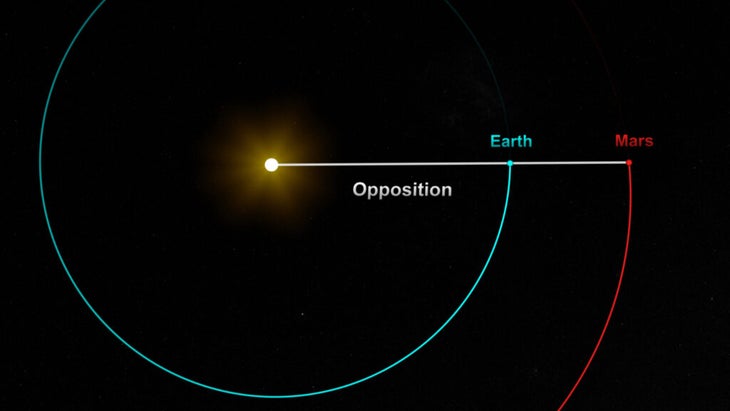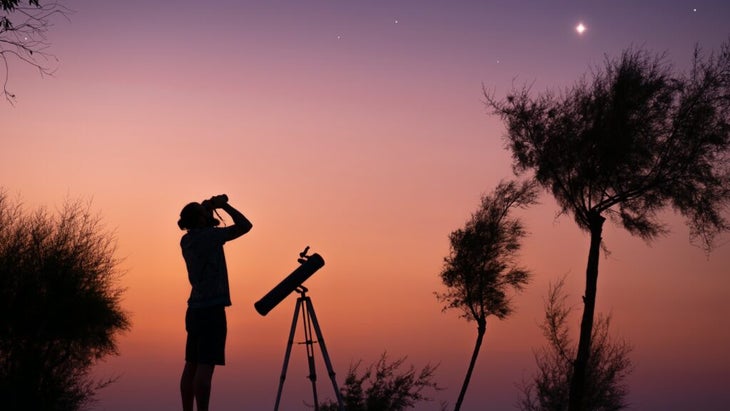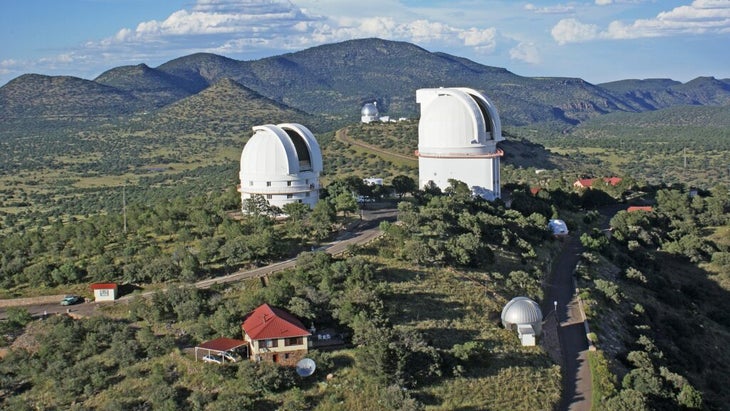Keep your eyes on Mars in our night sky this week. Our neighboring planet—the fourth from the sun in our solar system and approximately half the size of Earth—will look larger and brighter in our heavens than it has for the past two years, particularly Wednesday night. That’s when Earth will pass directly between Mars and the sun, putting us within 60 million miles of the Red Planet, roughly 42 percent closer than average.
Astronomers call this phenomenon opposition, and it affords prime sky-watching conditions. During opposition, a planet is closer to Earth, and we benefit from seeing the celestial body with the sun’s full glare, which makes it appear exceptionally vivid.

While we can enjoy the opposition of distant planets like Jupiter and Saturn almost every year, Mars is only in opposition once every 27 months because our orbits are closer, according to Royal Museums Greenwich. And this week marks its long-awaited moment in the sun.
Here’s when and how to best observe Mars during opposition. It won’t be this radiant again for us until 2027.
The Best Nights to View Mars During Opposition
Mars technically reaches opposition between January 15 to 16, but even now it’s already more luminous than usual. If you go outside tonight—or any night until Wednesday—the Red Planet will look spectacular and only get brighter as we near opposition.
Here’s a video of Mars next to the moon during the 2022 opposition, as viewed via a Nikon P1000 camera:
On January 13, we’ll see another interesting Martian sight: a lunar occultation, which occurs when this month’s full Wolf Moon slides in front of Mars. According to In-the-Sky.org, this will begin over the contiguous U.S. at 8:45 P.M. EST and will be visible to the naked eye above most of North America. (Exact timing and duration will vary by location.)
Throughout opposition week, if the sky is clear in your location, Mars will shine as vividly as Sirius, the night sky’s brightest star. But if you can only stay up late one night, I recommend the January 15 opposition, when the planet will be more dazzling to us on Earth than any time since December 2022.
Where to Spot Mars in the Sky During Opposition Week
Mars will rise in the east at dusk and set above the western horizon around sunrise. Seek out the planet’s tangerine tinge in the Gemini constellation (the hue will become bolder closer to opposition). Peak viewing begins around midnight, when Mars is highest in the sky.
Even in light-polluted cities, Mars is visible to the naked eye. I shot the following photo on January 7 while I was in San Diego, and visibility was still quite remarkable.

That said, a pair of binoculars—or better yet a telescope—will show off the planet’s surface details, including a vast canyon system and Olympus Mons, a volcano three times as high as Mount Everest.
If you’re new to planet-watching, download a stargazing app to navigate the heavens and to locate other prominent nearby celestial sights, like Jupiter and Sirius.
Regional Astronomy Events Celebrating Mars That Are Worth Traveling To

Consider attending a community astronomy night, where night-sky experts will show you the stars and planets via telescope. I found a half dozen excellent stargazing events across the country that will focus on the Mars opposition this week, but it’s always worth reaching out to your local astronomy club to see if it’s hosting any get-togethers for planet-gazing, too. (Note: all events below are weather permitting.)
The East
Chester, Pennsylvania
The astronomy and physics faculty at Widener University, just south of Philadelphia, are running a public Mars Night Stargazing Session at its observatory starting at 7 P.M. on January 15. Registration is required. As of publication, this event is at full capacity, but you can join the waitlist. Free
The South
Conway, Arkansas
At 6 P.M. on January 15, the University of Central Arkansas, located north of Little Rock, will open its observatory to the public for night-sky observations through a powerful Meade 14-inch-aperture LX200R telescope. Free
The Midwest

Jeff Davis County, Texas
The McDonald Observatory, located in West Texas but part of the University of Texas at Austin, will host a star party at 7 P.M. on January 14. Come for the amphitheater tour and stay for the telescope viewing. Advance registration is required. From $25
Kenosha, Wisconsin
Heide Observatory’s Wednesday Under the Stars aligns perfectly with the Mars opposition. The January 15 event begins at 6 P.M. at the Hawthorn Hollow Nature Sanctuary and Arboretum. Guides will lead guests through a tour of the night sky via laser pointer. Tickets are available here. $12
The West
Divide, Colorado
The Colorado Springs Astronomical Society is hosting a Mars-centered star party at Mueller State Park, 33 miles west of Colorado Springs, starting at 7 P.M on January 17. The event will take place at the park’s visitor center; no registration is required, but you will need a park pass (from $10).
Sunriver, Oregon
The Sunriver Nature Center and Observatory, roughly 20 miles south of Bend, is giving the public a prime view of Mars on January 15 starting at 7 P.M. The observatory has one of the largest collections of publicly accessible telescopes in the country, with staff astronomers at the ready to help visitors learn to use them. Registration is required. $28 for nonmembers; free for members

Stephanie Vermillion is Outside Online’s astrotourism columnist. She’s the author of the new National Geographic book, 100 Nights of a Lifetime: The World’s Ultimate Adventures After Dark, and she plans to watch Mars’s opposition on a stargazing getaway to Loreto, Mexico.


